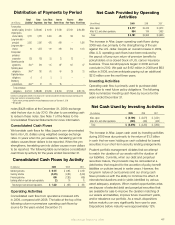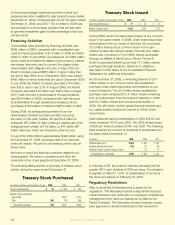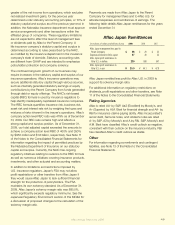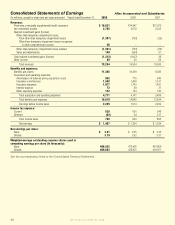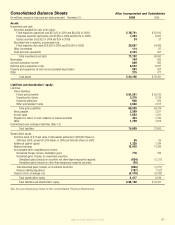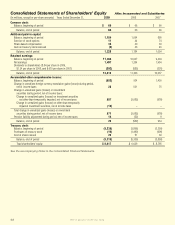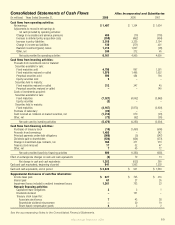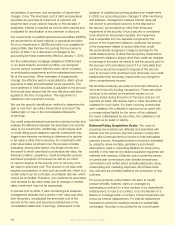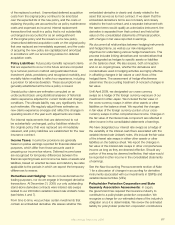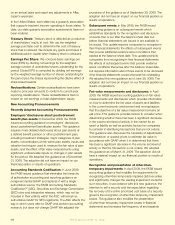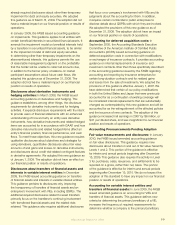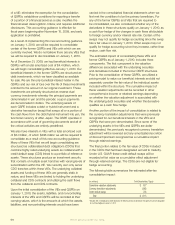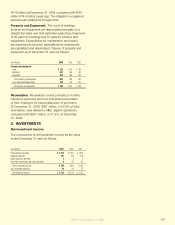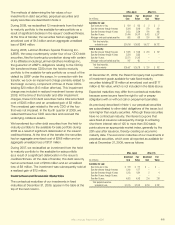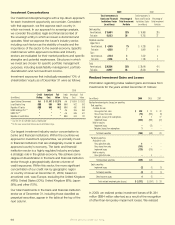Aflac 2009 Annual Report Download - page 61
Download and view the complete annual report
Please find page 61 of the 2009 Aflac annual report below. You can navigate through the pages in the report by either clicking on the pages listed below, or by using the keyword search tool below to find specific information within the annual report.
of the replaced contract. Unamortized deferred acquisition
costs from the original policy continue to be amortized
over the expected life of the new policy, and the costs of
replacing the policy are accounted for as policy maintenance
costs and expensed as incurred. Internal replacement
transactions that result in a policy that is not substantially
unchanged are accounted for as an extinguishment
of the original policy and the issuance of a new policy.
Unamortized deferred acquisition costs on the original policy
that was replaced are immediately expensed, and the costs
of acquiring the new policy are capitalized and amortized
in accordance with our accounting policies for deferred
acquisition costs.
Policy Liabilities: Future policy benets represent claims
that are expected to occur in the future and are computed
by a net level premium method using estimated future
investment yields, persistency and recognized morbidity and
mortality tables modied to reect our experience, including
a provision for adverse deviation. These assumptions are
generally established at the time a policy is issued.
Unpaid policy claims are estimates computed on an
undiscounted basis using statistical analyses of historical
claims experience adjusted for current trends and changed
conditions. The ultimate liability may vary signicantly from
such estimates. We regularly adjust these estimates as
new claims experience emerges and reect the changes in
operating results in the year such adjustments are made.
For internal replacements that are determined to not
be substantially unchanged, policy liabilities related to
the original policy that was replaced are immediately
released, and policy liabilities are established for the new
insurance contract.
Income Taxes: Income tax provisions are generally
based on pretax earnings reported for nancial statement
purposes, which differ from those amounts used in
preparing our income tax returns. Deferred income taxes
are recognized for temporary differences between the
nancial reporting basis and income tax basis of assets and
liabilities, based on enacted tax laws and statutory tax rates
applicable to the periods in which we expect the temporary
differences to reverse.
Derivatives and Hedging: We do not use derivatives for
trading purposes, nor do we engage in leveraged derivative
transactions. At December 31, 2009, our only outstanding
stand-alone derivative contracts were interest rate swaps
related to our ¥20 billion variable interest rate Uridashi notes
(see Notes 4 and 7).
From time to time, we purchase certain investments that
contain an embedded derivative. We assess whether this
embedded derivative is clearly and closely related to the
asset that serves as its host contract. If we deem that the
embedded derivative’s terms are not clearly and closely
related to the host contract, and a separate instrument with
the same terms would qualify as a derivative instrument, the
derivative is separated from that contract and held at fair
value on the consolidated statements of nancial position,
with changes in fair value reported in earnings.
We document all relationships between hedging instruments
and hedged items, as well as our risk-management
objectives for undertaking various hedge transactions. This
process includes linking derivatives and nonderivatives that
are designated as hedges to specic assets or liabilities
on the balance sheet. We also assess, both at inception
and on an ongoing basis, whether the derivatives and
nonderivatives used in hedging activities are highly effective
in offsetting changes in fair values or cash ows of the
hedged items. The assessment of hedge effectiveness
determines the accounting treatment of noncash changes in
fair value.
Until April 2009, we designated our cross-currency
swaps as a hedge of the foreign currency exposure of our
investment in Aac Japan. We included the fair value of
the cross-currency swaps in either other assets or other
liabilities on the balance sheet. We reported the changes
in fair value of the foreign currency portion of our cross-
currency swaps in other comprehensive income. Changes in
the fair value of the interest rate component are reected in
other income in the consolidated statements of earnings.
We have designated our interest rate swaps as a hedge of
the variability of the interest cash ows associated with the
variable interest rate Uridashi notes. We include the fair value
of the interest rate swaps in either other assets or other
liabilities on the balance sheet. We report the changes in
fair value of the interest-rate swaps in other comprehensive
income as long as they are deemed effective. Should any
portion of the swap be deemed ineffective, that value would
be reported in other income in the consolidated statements
of earnings.
See the New Accounting Pronouncements section of Note
1 for a discussion of changes in accounting for derivative
instruments associated with our investments in QSPEs and
variable interest entities (VIEs).
Policyholder Protection Corporation and State
Guaranty Association Assessments: In Japan,
the government has required the insurance industry to
contribute to a policyholder protection corporation. We
recognize a charge for our estimated share of the industry’s
obligation once it is determinable. We review the estimated
liability for policyholder protection corporation contributions
Aflac Annual Report for 2009 57


